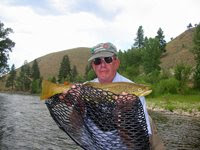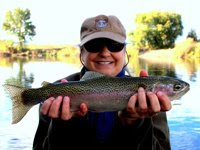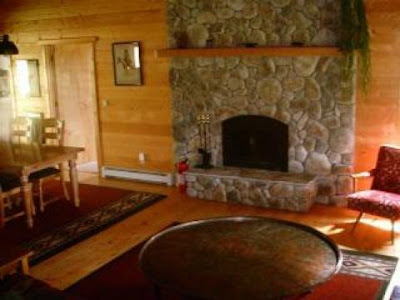
by Merle Ann Loman | Sep 21, 2012 | Bitterroot, iii Fall
This fishing trip was a birthday gift from his wife Heather. What a great thing to do for someone you love. Thanks Heather and Danny! Looks like it was a success. It actually happened in early September but I am keeping the post date of today Oct 29 to keep the post on top. Posted by Merle

by Merle Ann Loman | Oct 13, 2010 | Friends, hunting/fauna/flora, iii Fall
 |
| Betty and the pronghorn doe shot this year on opening day |
Our friends, Joe and Betty, love to fish and hunt. Betty is very successful. She shared a photo of her pronghorn (antelope) doe she shot on opening day this year. I found a photo of a buck she shot a few years ago. They are great photos and she said I could blog them. Here they are.
Betty is like me, she does it all. She doesn’t stop after shooting, she retrieves her game and takes care of the meat.
 |
| Betty and the buck she shot a few years ago |
by Merle Ann Loman | Jun 25, 2010 | Conservation/benefits/organizations, River
Montana Audubon and guides and outfitters speak up about climate change concerns.
Derek Goldman works for Montana Audubon out of Missoula, Montana. He is concerned about climate changes and impacts on Montana resources. He is reaching out to fly fishing outfitter and guides and asking them to speak up if they share his concerns. He has prepared a letter and is asking for signatures.
Here is the body of his draft letter.
Dear Senator Baucus, Senator Tester and Congressman Rehberg,
As fishing guides and outfitters in the state of Montana, we are writing to express our concerns about the impacts global climate change is having on our rivers, our fish, and our livelihoods, and to encourage you to support energy legislation that includes a strong, science-based cap on greenhouse gas emissions.
In Montana, we are fortunate to have more than 170,000 miles of rivers and streams meandering through our state. (Only Alaska, California and Texas can boast of more waterways than Montana.) Many of these rivers provide habitat for various species of game fish, including native Cutthroat trout, Bull trout, and Arctic grayling. Healthy fish populations and quality habitat are critical for our small businesses and for our way of life. The persistence of this world class fishery, for which Montana is famous, is in peril.
Climate impacts on Montana streams
Today global climate change threatens the health of our streams and the quality of native fish habitat. Studies of 50 years of climate data shows that total annual snowfall has decreased—by 6.3 inches annually in Great Falls to more than 22 inches in Missoula. At the same time, average March temperatures in Montana increased about 5.5° F.3 This is having a dramatic effect on the timing of spring snowmelt, resulting in a 30 percent drop in average spring snowpack throughout the state.
As a result, we are experiencing declining average stream flows and run-off that peaks several weeks earlier in the spring. Unfortunately this does not bode well for our native fish in Montana, many of which are absolutely dependent on cold water. The reduced snowpack and earlier melt-off results in less water in the rivers during the summer as well as warmer stream temperatures that can be lethal to our native trout. In fact, in recent years, Montana Fish, Wildlife and Parks managers have been forced to close many streams to all angling to protect fish from added stress.
Economic impact of fishing in Montana
America’s 44 million anglers play a major role in our economy, creating 1.1 million jobs and contributing $116 billion in overall economic output.5 Here in Montana, nearly 350,000 people fish annually (39 percent of whom are nonresident visitors) and spend $292 million on equipment, guiding services, lodging and other related expenditures.These anglers create 3,100 jobs in Montana, which pay $50 million in wages and salaries. Putting the breaks on greenhouse gas pollution is critical in order to keep these Montana jobs and associated economic benefits, and to provide the stability our businesses will need to persist in an uncertain future. This holds true for fishing guides and outfitters and also for the many other small businesses—from farmers to ski areas—that stand to lose if we fail to act.
Conclusion
As Congress moves forward in consideration of clean energy and climate legislation, we urge you to support strong, science-based limits on the greenhouse gas pollution that is causing global climate change and impacting Montana’s streams and native fish. Legislation should also maintain the integrity of our Clean Air Act, and provide investments in renewable energy as well as adequate funding to safeguard fish and wildlife from the worst effects of global warming.
Thank you. (followed by signatures)
You can click here for a printable version of letter in PDF format. The printable version includes citations. Contact Derek if you want to sign the letter or have comments or questions.
Derek Goldman, Field Representative
Montana Audubon
405 S 1st St. West
Missoula, MT 59801
Office: (406) 549-2848 ext.2
dgoldman@mrss.com
www.mtaudubon.org

by Merle Ann Loman | Oct 23, 2009 | Big Hole, Bitterroot, Blackfoot, Clark Fork, i Spring, ii Summer, iii Fall, Missouri
 “When is the best time to fish western Montana?” This is the question I am most often asked. In my attempt to answer it, I will take a brief look at our seasons chronologically and try to highlight a few of the more memorable fishing moments in an ‘average’ year.
“When is the best time to fish western Montana?” This is the question I am most often asked. In my attempt to answer it, I will take a brief look at our seasons chronologically and try to highlight a few of the more memorable fishing moments in an ‘average’ year.
Naturally we will begin with spring. Fish are coming out of a dormant period by mid-March with milder weather and water temperatures. Spring with its predictably unpredictable weather does have its special moments. The Bitterroot, Big Hole, Blackfoot, Clark Fork and Missouri will ‘come in’ at different times from mid-March through May. Naturally extreme weather (too cold OR too warm) can ruin the angling, yet spring has some wonderful hatches. You will see stoneflies; Skwalla and Nemoura, mayflies; March Brown and Blue-winged Olives (BWO), and lastly caddis that can trigger some unbelievable opportunities. Fishing “underneath” with either nymphs or streamers can also be very productive. One must be somewhat of a gambler to fish in the spring. The rewards can be gratifying for the lucky angler who strikes it rich.
Starting in mid-May, rivers will begin to surge as warm, mild weather begins melting the snowpack. A typical run-off will last over a period of about 5 weeks or so depending on the amount of snowpack. However, the craziest streamer and nymph fishing ever has happened between run-off pulses during this time period.
Early summer is probably the most popular time to fish western Montana, right after main run-off events are over, typically around mid-June, river flows decrease and gain clarity. Hatches of salmonflies, golden stones and green drake mayflies make their annual appearance. This can be an especially productive time for the inexperienced angler as trout are hungry, relatively uneducated, and the water is fast and forgiving. One can get away with a little more drag on the surface fly and use heavier tippets and larger patterns. For many of my fisherman, the last 10 days of June and first 10 days of July are the best time to fish. It is difficult to argue as the good hatches, healthy river flows and early summer weather are hard to beat. It is also the time of year that most people are recreating on our area rivers and is to be expected. Wapiti Waters does its best to avoid getting into a crowded fishing scene and having to “compete.”
Eventually the fishing settles down into mid-summer rhythm, always dependent on weather, the explosive hatches of larger insect species is over and too many days of hot weather really slows down the trout. Mid-summer slides into the so-called ‘dog days’ with morning PMDs spinner falls and the Isoperlid Stoneflies like yellow sallies are about the only aquatic insects out there. However there have been memorable moments in certain river reaches with terrestrial patterns like beetles, ants, grasshoppers and moths. This time period (mid-July through mid-August) is an excellent time to be on the water particularly for the early riser as the morning fishing can be very good. Many Wapiti waters customers prefer this time as area rivers have noticeably less fishing pressure.

At the end of August, longer nights and cooler weather turn on the bugs and the trout. The tiny black curse (trico mayfly) begins to make its appearance and cloud up the morning sky with its mating dance. Once on the water these little bugs give anglers the most challenging as well as rewarding fishing opportunities of the year. The patterns are small; one’s casting must be accurate and soft and hooks sets slow. In other words good technique is usually required. But because the opportunities for finding rising trout are numerous, you can get a lot of practice refining your technique. After a morning of trico fishing, an afternoon of hopper and/or fall drakes is likely to follow. For many dry fly purist, this time period is best as fish can be found rising throughout the day.
Later in September, the above mentioned hatches are followed by BW and mahogany dun mayflies, October caddis and midge swarms that take us right into late-fall. During our fall fishing one can expect to find pretty consistent hatches, sipping trout and fall colors that make this my personal favorite time to fish. This is a quality time particularly for the late riser as afternoon fishing is the norm.
We hope this answers the question about the best time to fish. I don’t like to promise good fishing just because you’re booked, say the first week of July or early September. So much of the fishing depends upon factors we have no control over such as weather and stream flows …but when the fishing is just tough we will always go back to the Robert Traver quote, “I fish because I love to; Because I love the environs where trout are found…” See the entire quote below and Thank you for reading this article.
No matter what time of year, Wapiti Waters always works hard to find your best fishing.
THE TESTAMENT OF A FISHERMAN
Robert Traver 1964, (Judge John Voelker 1903-93)
I fish because I love to;
Because I love the environs where trout are found, which are invariably beautiful, and hate the environs where crowds of people are found, which are invariably ugly;
Because of all the television commercials, cocktail parties, and assorted social posturing I thus escape;
Because, in a world where most men seem to spend their lives doing things they hate, my fishing is at once an endless source of delight and an act of small rebellion;
Because trout do not lie or cheat and cannot be bought or bribed or impressed by power, but respond only to quietude and humility and endless patience;
Because I suspect that men are going along this way for the last time, and I for one don’t want to waste the trip; because mercifully there are no telephones on trout waters;
Because only in the woods can I find solitude without loneliness;
Because bourbon out of an old tin cup always tastes better out there;
Because maybe one day I will catch a mermaid;
And, finally, not because I regard fishing as being so terribly important but because I suspect that so many of the other concerns of men are equally unimportant – and not nearly so much fun.
See photos from early spring through late fall in the slideshow below.
View AlbumClick view album to see in new larger window, choose “slideshow” for full screen mode.

by Merle Ann Loman | Sep 1, 2009 | Associates - we recommend..., Bitterroot, i Spring, ii Summer, iii Fall, iiii Winter/Snow, Lodging
This place is absolutely wonderful. It is fresh, clean, beautiful, centrally located for fishing the Bitterroot River, yet in a country setting near Forest Service hiking trails in the Bitterroot Mountains. It is 35 miles from Missoula, less than 5 miles west of Victor (Victor is on Highway 93). Amy is fantastic to work with! Read on…

Description by Amy Sage:
SweetSage Guest House, built in 1996, combines the elements of a historic Bitterroot ranch with a quiet, private setting, and all of the modern comforts of home.
The Guest House sits on an 80-acre homestead ranch just a few miles west of the town of Victor and Highway 93, and less than a mile from an infrequently traveled hiking trail in Sweathouse Creek Canyon. Sweathouse Creek was named for the Salish Indian sweat lodges that dotted its banks up until the late 1880s. The ranch is certified organic, and home to a variety of farm animals: horses, sheep, cashmere goats, chickens and cattle.
At SweetSage Guest House you will find a fully equipped kitchen, barbecue grill, nice laundry facility, satellite TV, and phone. The kitchen, dining and living rooms are all one open room with high ceilings and a large stone fireplace. From the deck, visitors can view the majestic peaks of the Bitterroot Mountain range and a variety of wildlife, including deer, elk, bear, coyotes, eagles, owls, hawks and numerous other birds.
The 3 bedroom, 2 bathroom home can sleep up to six people comfortably. Two bedrooms have king size beds; the remaining bedroom has two twin beds, all complete with down comforters! There is also a queen size futon for one or two extra people. Central heating keeps the house warm and cozy in all seasons.
SweetSage Guest House is located on an historic Bitterroot ranch dating back to the 1880s. The barn outbuildings are still in use today and we invite you to tour our heritage. The spacious rooms and huge decks at SweetSage Guest House promise to provide the perfect backdrop for entertaining, wildlife viewing or just relaxing.
Click here to see the SweetSage Guest House listing on Vacation Rental by Owner in Victor
Ask Amy about her “Sweet Heart Special” of $975/week for up to two people
Phone: (406) 642-6400
Email: sweetsage@bitterroot.com
Inquire/Contact the owner for more info
SweetSage Guest House Rates:
Peak Season: May 1 – Oct 31
Rate per night/$275, per week/$1450, per month/$2200
Minimum stay is 3 nights
Off Peak Season: Nov 1 – April 30
Rate per night/$250, per week/$1250, per month/$2200
Minimum stay is 3 nights
The SweetSage Guest House is Pet Friendly – Please Check!
This is a non-smoking property.








